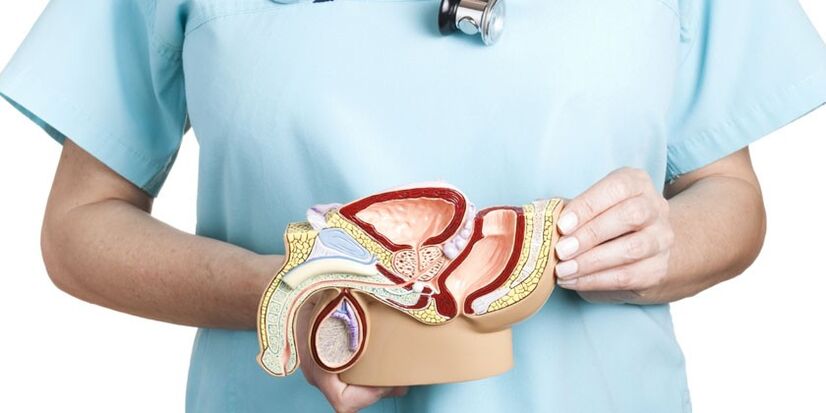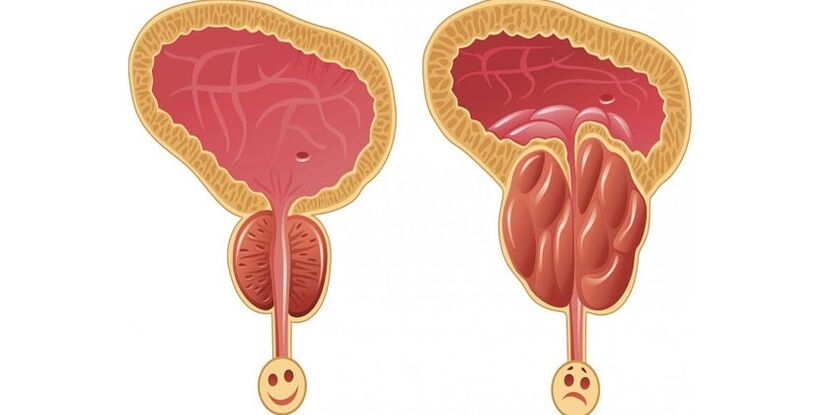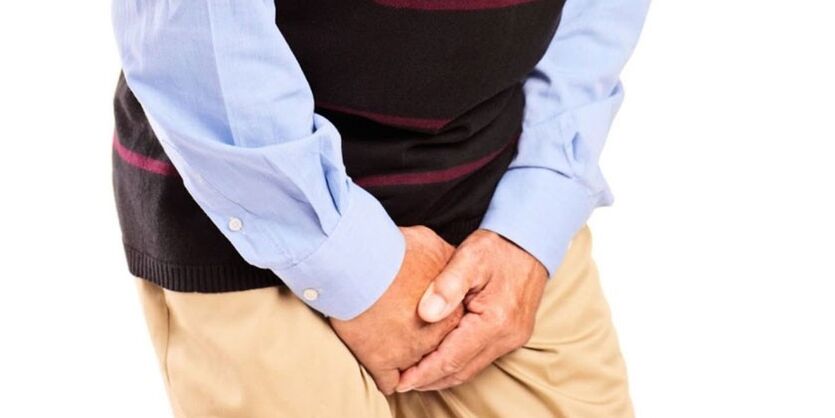According to statistics, more than 75% of men aged 40-45 suffer from prostate disease. The intense circulation of lymph and blood in the small pelvic vessels often causes swelling and congestion of the organs. In addition, the prostate is well innervated, so symptoms in men include severe pain.
what is the prostate
The prostate, or prostate, is the male reproductive organ and part of the reproductive system. It is located in the small pelvis, below the bladder, and partially covers the urethra and ejaculatory ducts. The prostate consists of two lobes and an isthmus connecting them. Also, among the organs a distinction is made between top, bottom, front and back. The prostate gland is shaped like a chestnut, elastic and composed of glandular cells and muscle cells. The prostate performs three main functions:
- motor. The muscle cells of the prostate form a sphincter in the urethra to hold urine.
- secretary. The gland produces a special secret that makes the sperm fluid and liquefies the sperm.
- barrier. Prevents the spread of infection from the urinary tract.
male prostate disease
Typically, pathology is associated with damage to organs by pathogenic and opportunistic microorganisms, hyperemia, or neoplasm (malignant and benign). >Prostate disorders include:
- inflammation (prostatitis);
- benign hyperplasia of the gland (adenoma);
- malignancy (cancer);
- Cystic tumors;
- Prostatic abscess.
Many factors that create a favorable environment and conditions for the penetration and multiplication of pathogenic microorganisms (fungi, viruses, bacteria) cause the development of pathology and the onset of signs of inflammation in the male prostate. In addition, they may also lead to the development of benign or malignant tumors. Disadvantages include:
- Malnutrition;
- vitamin deficiency;
- venereal disease;
- hypothermia;
- Lack of motivation;
- long-term antibiotic therapy;
- blood stagnation in the pelvis;
- bad habits;
- endocrine disease;
- reproductive system pathology;
- Neoplastic disease in history;
- Chronic fatigue.

Symptoms of Prostate Disease in Men
Signs of prostate destruction depend on the cause of the disease, its localization and the nature of the pathological process. Typically, patients complain of weakness, decreased performance, general fatigue, and irritability. In addition, symptoms of prostatitis, prostate adenoma, stones, or abscesses in men can manifest as:
- violation of urination;
- erectile dysfunction;
- infertility;
- pain, burning in the urethra;
- temperature rise;
- chills;
- painful intercourse;
- lack of ejaculation;
- Pain in the perineum with sudden movement;
- Aggressive discharge from the urethra.
prostatitis
Inflammatory lesions of the prostate, or prostatitis, are one of the most common diseases of the male genital area. The main cause of the pathology is considered a violation of the blood circulation in the pelvis, which leads to a strong increase in the proportion of the organ and its edema. Symptoms of prostatitis depend on the type of disease. There are several types of pathology:
- Acute inflammation. Caused by pathogenic microorganisms such as Escherichia coli or Enterobacteriaceae. Acute prostatitis manifests as severe pain at the urethral opening, pain, and dysuria: it is difficult to excrete urine, sometimes drop by drop. Some patients reported elevated body temperature.
- Chronic bacterial inflammation. Usually, it is caused by a sexual infection (chlamydia, gonorrhea, trichomoniasis, etc. ). Symptoms of chronic inflammation of the prostate may be mild or absent. Among the characteristic signs, sexual dysfunction (erectile dysfunction, premature ejaculation), painful urination (mainly nocturnal) and mucus discharge from the urethra are noted.
- Chronic nonbacterial inflammation. The disease develops due to inflammatory processes in other organs (pyelonephritis, cystitis), blood stagnation, heart failure, hypothermia. This kind of prostatitis often has one symptom - dysuria. The result of pathology is usually a violation of the kidneys, discomfort in the lower back.
benign prostatic hyperplasia
A disorder of the prostate gland characterized by the growth of benign tissue and the formation of nodules that progressively compress the urethra and vas deferens, bladder. Hyperplasia can lead to disruption of hormone concentrations in the blood. The signs of prostate adenoma in men vary depending on the stage of the disease:
- compensate. Often, men do not notice specific symptoms during this stage. Sometimes the urge to urinate increases at night.
- sub compensation. The main symptom is a feeling of heaviness in the bladder, with incomplete emptying. Fluid is difficult to pass during urination, and the patient complains of difficulty ejaculating.
- decompensation. It is characterized by a significant decrease in the volume of the bladder muscle and its tone. In addition, adenomas can experience chronic fatigue, pain, and cramping when trying to urinate. In untreated cases, the tumor grows, the intensity of the pain increases markedly, and bowel movements may be disturbed by pressure on the rectum.
Prostate adenomas are considered precancerous, so when this tissue growth is detected, a biopsy to detect atypical cells and an ultrasound (ultrasound) are required to study the structure of the organ in detail. Usually, glandular hyperplasia progresses slowly and can be diagnosed and treated in time.

cyst
Under the influence of inflammatory processes in the gland, pathological cavities with fluid or cysts of the prostate appear, in which the excretory duct of the organ is squeezed and the outflow of secretions is disturbed. Constant stress, nervous tension, chronic diseases and tumors in adjacent organs, hardening of the prostate tissue may trigger the pathology. Signs of cyst formation are:
- burning in the urethra;
- enlarged glands;
- decreased libido;
- elevated body temperature;
- A feeling of incomplete emptying of the bladder;
- reproductive dysfunction.
Stone
Prostate stones are formed due to a sedentary lifestyle, injuries to the groin area, inflammatory diseases of the organ. The stones gradually increased, violating the integrity of the duct, and urine began to enter the prostate tissue. Typically, stones are composed of phosphate, urate, and oxalate, protein, and ductal epithelium. Cardinal signs of pathology include:
- erectile dysfunction;
- pain when urinating;
- frequent exacerbations of inflammation;
- pain during ejaculation;
- Closed gland, painful on probing.
cancer
Malignant tumors that develop from the secretory epithelium of the prostate are called carcinomas or carcinomas. A long-term inflammatory process precedes tumor development. High-risk groups include men over 40 who drink heavily and smoke. Symptoms of prostate tumor damage are nonspecific and manifest as impaired organ function. In the early stages, the disease usually does not manifest itself. As the tumor progresses, symptoms such as:
- hematuria;
- painful urination;
- lower abdominal pain;
- swelling of the legs;
- Violation of the chairman's regulations;
- impotence.
abscess
Infectious inflammatory pathology with purulent fusion of tissues is called abscess. This process occurs due to the transfer of pathogenic bacteria from the main focus of infection to the prostate through the bloodstream. For a long time, an abscess may have no symptoms. The main signs of the presence of purulent lesions in the prostate tissue are: >
- fever and fever;
- Pain during intercourse and urination;
- Discharge of foul-smelling pus in urine (when an abscess ruptures).
Diagnosis of suppurative formations in the prostate with the help of instruments and laboratory studies. In blood tests, an increase in the number of white blood cells and an increase in the value of the erythrocyte sedimentation rate are noted. In urine studies, leukocyturia and pathogenic flora were detected. Palpation of the rectum revealed the presence of rounded structures.

The main methods of treating the prostate
The method of treating the pathology depends on the specific disease, its stage and its severity. Treatment of prostate diseases is selected individually depending on the age of the patient, the results of laboratory tests, instrumental studies, the presence of concomitant disorders. Familiarize yourself with the basic principles of prostate disease treatment:
disease |
treatment method |
|---|---|
prostatitis |
|
adenoma |
|
cyst |
|
Stone |
|
cancer |
|
abscess |
|
prevention
To prevent the development of prostate disease, the principles of a healthy lifestyle should be followed. Follow these recommendations to reduce your risk of prostate lesions:
- Stick to a balanced diet.
- Exercise regularly.
- Taking multivitamin complexes, immunomodulatory drugs.
- Quit drinking, smoking, drugs.
- Avoid hypothermia.
- See your doctor as soon as possible if you develop symptoms.

























